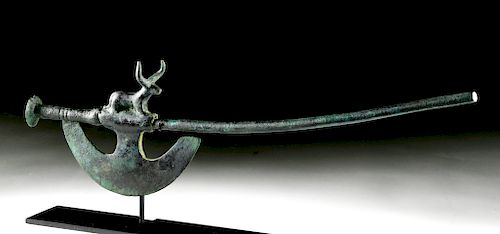Near Eastern Copper Ceremonial Axe with Bull
Lot 93a
About Seller
Artemis Gallery
686 S Taylor Ave, Ste 106
Louisville, CO 80027
United States
Selling antiquities, ancient and ethnographic art online since 1993, Artemis Gallery specializes in Classical Antiquities (Egyptian, Greek, Roman, Near Eastern), Asian, Pre-Columbian, African / Tribal / Oceanographic art. Our extensive inventory includes pottery, stone, metal, wood, glass and textil...Read more
Estimate:
$30,000 - $45,000
Absentee vs Live bid
Two ways to bid:
- Leave a max absentee bid and the platform will bid on your behalf up to your maximum bid during the live auction.
- Bid live during the auction and your bids will be submitted real-time to the auctioneer.
Bid Increments
| Price | Bid Increment |
|---|---|
| $0 | $25 |
| $300 | $50 |
| $1,000 | $100 |
| $2,000 | $250 |
| $5,000 | $500 |
| $10,000 | $1,000 |
| $20,000 | $2,500 |
| $50,000 | $5,000 |
| $100,000 | $10,000 |
| $200,000 | $20,000 |
About Auction
By Artemis Gallery
Feb 21, 2019
Set Reminder
2019-02-21 10:00:00
2019-02-21 10:00:00
America/New_York
Bidsquare
Bidsquare : Exceptional Antiquities, Asian, Ethnographic
https://www.bidsquare.com/auctions/artemis-gallery/exceptional-antiquities-asian-ethnographic-3858
An important one-day auction featuring museum-worthy examples of Egyptian, Greek, Roman, Etruscan, Near Eastern, Far East / Asian, Pre-Columbian, African / Tribal, Oceanic, Native American, Spanish Colonial, Russian, Fossils, Ancient Jewelry, Fine Art, so much more! Artemis Gallery info@artemisgallery.com
An important one-day auction featuring museum-worthy examples of Egyptian, Greek, Roman, Etruscan, Near Eastern, Far East / Asian, Pre-Columbian, African / Tribal, Oceanic, Native American, Spanish Colonial, Russian, Fossils, Ancient Jewelry, Fine Art, so much more! Artemis Gallery info@artemisgallery.com
- Lot Description
Ancient Near East, ca. 2nd millennium BCE. A stunning ceremonial axe made from copper and cast in separate pieces via the lost wax (cire perdue) method. The axe blade is of a crescent form with curved termini and a tubular hafting sleeve projecting opposite the sharpened edge. Atop the hafting tube stands a stocky bull effigy with nubbin-form legs, a sinuous tail, a thick neck, and a conical head from which projects a grand pair of pointed horns. A long, slightly-curved cylindrical rod is secured within the upper tube, with a flat terminal on the longest end, and a flaring finial; this rod was perhaps meant as a tang to be wrapped with ivory or leather wraps. High-quality ceremonial weapons like this example were not typically used on the field of battle or for sacrificial purposes but were votives to be deposited in burials along with other valuable offerings. An exquisite example covered in layers of lustrous green and brown patina. Custom museum-quality display stand included. Size: 21.5" L x 6.625" H (54.6 cm x 16.8 cm); 8.125" H (20.6 cm) on included custom stand.
Cf. an Amlash axe and rod in an Iranian collection, published in "7000 Years of Iranian Art" (Washington DC, 1964), cat. No. 125, pp. 64 & 132
Provenance: private East Coast, USA collection; ex-private Texas, USA collection; ex-private Rosen Family collection, acquired in the 1980s
All items legal to buy/sell under U.S. Statute covering cultural patrimony Code 2600, CHAPTER 14, and are guaranteed to be as described or your money back.
A Certificate of Authenticity will accompany all winning bids.
We ship worldwide and handle all shipping in-house for your convenience.
#141449Rod is ancient but may not be original to the axe head. Slight bending to overall form of blade, pole, and bull horns, light encrustations, and small nicks to rod ends and blade edge, otherwise intact and excellent. Light earthen deposits as well as fabulous green and brown patina throughout.Condition
- Shipping Info
-
All shipping is handled in-house for your convenience. Your invoice from Artemis Gallery will include shipping calculation instructions. If in doubt, please inquire BEFORE bidding for estimated shipping costs for individual items.
-
- Buyer's Premium



 EUR
EUR CAD
CAD AUD
AUD GBP
GBP MXN
MXN HKD
HKD CNY
CNY MYR
MYR SEK
SEK SGD
SGD CHF
CHF THB
THB













